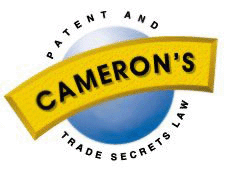
Case Comment
Johnson Controls, Inc. v.
Varta Batteries Ltd.
citation(s): (1984) 80 C.P.R. (2d) 15
 Case Comment |
Johnson Controls, Inc. v.
|
copyright 1997 Donald M. Cameron, Aird & Berlis
"In the case at bar, on the other hand, the trial judge made a number of findings in the passages from his reasons which I have quoted above and concluded (accepting as he was entitled to do the evidence of Varta's expert witness) that "the real invention here was not that of the patent but rather than of a suitable plastic" [at p. 139]. Since this was a conclusion based on the particular evidence to which he referred and from inferences which he was entitled to draw from the whole of the evidence, there being support therein for such inferences, his finding ought not to be disturbed by this court.
I am fortified in my view that this is the correct view of the case by what was said by Rinfret C.J.C. in The King v. Uhlemann Optical Co. (1951), 15 C.P.R. 99 at pp. 104-5, [1952] 1 S.C.R. 143 at p. 151, 12 Fox Pat. C. 65 (quoting Terrell on Patents, 7th ed., p. 71]:
`It would seem to be necessary to fix upon some definition of invention, but this has never been done, and in my opinion no definition of invention can be found which is of the slightest assistance to anyone in a case of difficulty... When you approach the dividing line it is so impossible to get a test that it becomes, more or less, a matter of personal opinion. Some of the elements of a combination are altered so as to improve, but not essentially change its working. Is that a new invention? If it is only the substitution of mechanical elements which are notoriously the equivalents of the old elements the law is clear, but in any other case it is treated as being a question of fact for the judgment of whatever tribunal has the duty of deciding.'
"In reaching this conclusion I have not overlooked the fact that, as pointed out by counsel for Johnson, in England in the case of Joseph Lucas (Batteries) Ltd. et al v. Gaedor Ltd. et al., [1978] R.P.C. 297, Whitford J. in the Chancery Division of the High Court of Justice in a patent infringement action involving the same battery case, found that the step taken leading to a battery with walls as thin as 0.100 inches or less was not an obvious one. The short answer to the submission that such a finding should have been so persuasive to the trial judge in this action as requiring him to follow it, is that the learned judge in the English case reached his opinion on the evidence which had been adduced before him, as he appreciated it, while the trial judge in the case at bar reached the opposite conclusion on the evidence in the case before him. Both conclusions may well have been supportable in the context of the respective cases. While undoubtedly of some persuasive value, the findings of Whitford J. were not binding either on the trial judge in this case nor on this court. If the trial judge's opinion in this case is supportable on the evidence, as I believe it is, the opinion of another judge in another case may be both of interest and persuasive, but is not of binding authority."
"In this case counsel submitted that in construing the claims in order to determine the true invention contemplated by the inventor, the court is entitled to look only at the language used in the disclosure portion of the specification, but also at contemporary documents prepared by the inventor. On this basis, for the purpose of establishing that his client's "through-the-partition" connection differed from that of Johnson, counsel placed heavy reliance on a report, adduced in evidence at trial as ex. D-22, prepared by one of the inventors, Orlando, on August 15, 1960. In counsel's submission this document established the essential parameters of this invention. There is some significance in the fact that the record discloses that the application for the United States patent upon which the patent in suit was based, was filed on August 21, 1961, a year after ex. D-22. As will be recalled, the Canadian patent issued on May 4, 1965.
Since it is clear from the jurisprudence (e.g. Lovell Mfg. Co. et al v. Beatty Bros. Ltd. (1962) 41 C.P.R. 18 at pp. 37-8, 23 Fox Pat. Co. 112 at p. 130-1, that even the testimony of the inventor is not admissible for the purpose of describing his invention, I find it difficult to believe that statements made in a document by one of the inventors a year before the patent was ever applied for, is relevant in construing the claims. Rather, the claims themselves should be examined and then only if the language used in them is not plain and unambiguous, need reference be made even to the disclosure portion of the specification to construe them."
Return to:
Cameron's IT Law: Home Page; Index
Cameron's Canadian Patent & Trade Secrets Law: Home Page; Index